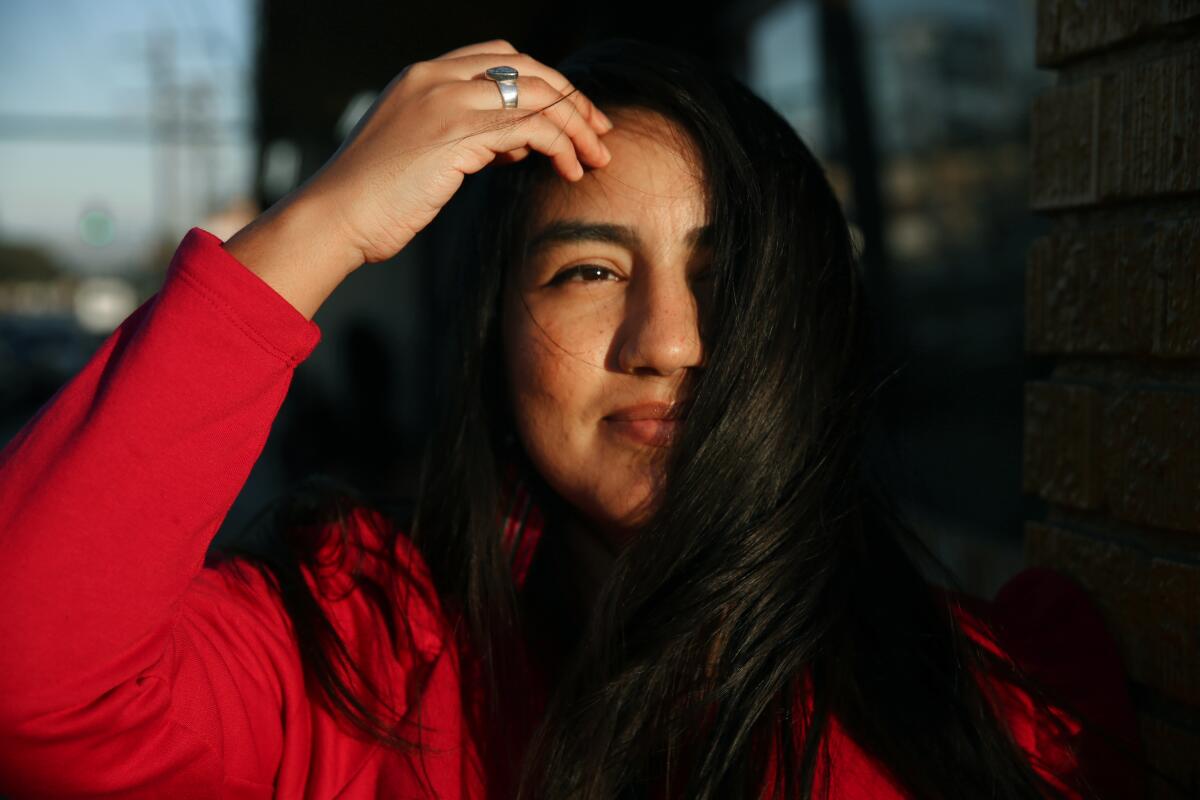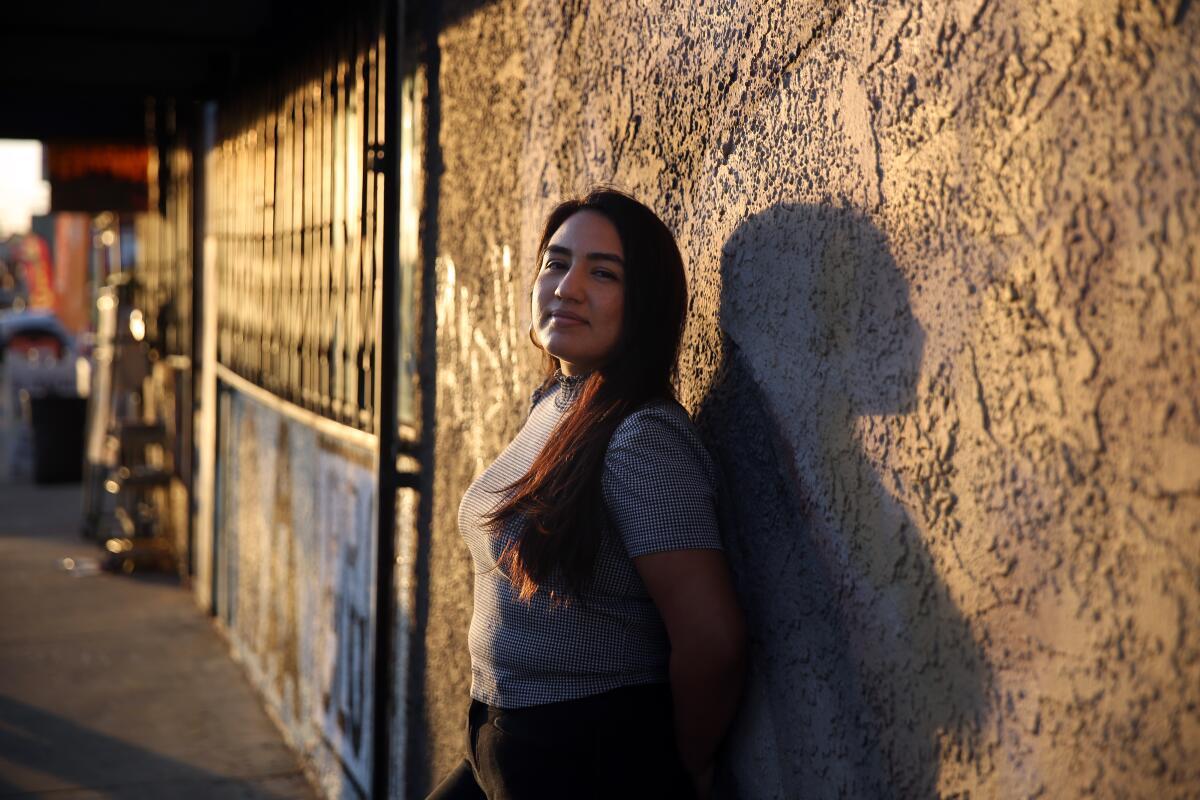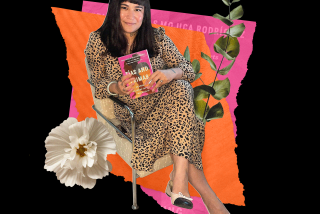She photographs Latinx tribute artists through an LGBTQ lens
- Share via
For her new photography series “Caricias,” Arlene Mejorado sees herself as not only an artist but more important, as a collaborator, a curator and a friend to the people she’s photographing: LGBTQ people, primarily trans women, who perform as Selena Quintanilla, Jenni Rivera, Juan Gabriel and others at nightclubs, restaurants and backyard tent parties all across Los Angeles.
Mejorado eschews decisive moments for empathetic context, weaving interviews, portraits and autobiography into a multimedia series that gives testimony to the cathartic power of these LGBTQ drag performances.
“I’m interested in back story versus being the storyteller who offers the narrative of a photo,” she said.
For strict documentarians drawn to larger-than-life moments that speak without context, work like Mejorado’s might be easy to dismiss. And for the artist herself, acceptance hasn’t always been easy. When Mejorado, 31, was in New York last summer for a Magnum Foundation fellowship, she arranged to workshop her project at the home of photographer Joseph Rodríguez. Mejorado, who is self-taught, was feeling overwhelmed. Round-the-clock group critiques and classes can rack any artist with self-doubt. For Mejorado, questions of belonging were accompanied by questions of skill, and whether her approach was good enough.
Rodríguez sat her beside his books of great Latin American photographers: Manuel Álvarez Bravo, Graciela Iturbide. What Mejorado needed, Rodríguez told her, was to accept that she saw the world as they did. She was not an outsider to photography. She had a home.

In trying to imagine a life in the arts, Mejorado had no example in her family — shoemakers who left Mexico in the 1980s. As a kid in Panorama City, she sought approval from her older male cousins, doing whatever they did but still never being fully accepted. “You’re a girl,” Mejorado remembered her cousins saying.
In her early 20s, Mejorado, who identifies as queer, almost gave up on the arts entirely. But then she met Margaret Garcia, a portraitist in Highland Park who opened her studio on Thursday nights to the neighborhood. Mejorado was challenged to paint fast. Garcia’s models had families to feed, jobs. Mejorado gathered what was conspicuous, finding beauty in strong features.
Then in 2008 Garcia took Mejorado to a talk at the Getty, where they met Iturbide. Meeting Iturbide, much like seeing her books at Rodríguez’s, reinvigorated Mejorado with confidence. By 2016, she won some national recognition: A portrait of Mejorado’s was made into a graphic by Shepard Fairey titled “Defend Dignity” and seen prominently at the 2017 Women’s March.
Mejorado thinks forgetting can be a salve to trauma. With “Caricias” she asks her collaborators to remember, to share stories of their past, to resurface, say, a photograph tucked away in a shoe box. Mejorado collages these found photographs with backdrops of sequins and silk, fabrics used by the performers for their dresses and jackets. A doubling of time — a snapshot of a long-ago Christmas, placed atop present-day context — becomes evidence of then and now, giving performers breath to shape their own narrative.
Mejorado makes candid portraits of the performers while they’re on the stage, and she directs quieter ones off of it. They are posed, stilled, offering another thread into a performer’s life.
The photographer also is drawn to ruptures of etiquette. In her pictures of quinceañeras, baptisms and First Communion celebrations, a few men grope performers from behind or stuff dollar bills into the seams of costumes while family members of all ages are recording with their phones.
“I don’t believe in being a fly on the wall,” Mejorado said of her immersion into a scene. “I do take up space.”
And just as well. She gives performers a say in how they are shown, and they in turn give Mejorado tips on mise-en-scène and tone.
Lately, the pre-colonial god Tezcatlipoca, translated as the Smoking Mirror from Nahuatl, has been on Mejorado’s mind. She has been thinking about how we are reflections of one another, seeing ourselves, good or bad, in somebody else.
“I want to create reflections, not representations,” she said. “I want you to see yourself in someone, even though that someone might look nothing like you.”
In “Caricias,” the aim is to reflect the emotional labor of the performers.
Many of them migrated from Central America or Mexico to escape abuse or poverty. They carry a lineage of hurt and heartbreak. In the U.S., where some find a chosen family and earn good money, abuse and alienation can still follow. Yet while onstage, some of the performers are able to joke nonchalantly about rape or coyotes or racism. Then, like a spring bloom, song: “Como la Flor,” “Hasta Que Te Conocí,” “Paloma Negra.” “Like the Flower,” “Until I Met You,” “Black Dove.”
In some photographs, the crowd is transcendent — applauding, crying, as though they have seen Selena resurrected.
The series is incisive when critiquing the families who are paying for the entertainment. Mejorado is still waiting for a moment when the performer is treated as neither a curiosity nor a savior but rather a friend or ordinary human being. Will it ever happen? In some photographs, men recoil at the performer’s caress (the English translation of caricia).
For the performers, the stage provides a brief spell in which trauma fades. In song, they are embodiments of joy and heartbreak, channeling grace. “But there’s still this sense of them being an outsider,” Mejorado said, “They’re never at home.”

More to Read
The biggest entertainment stories
Get our big stories about Hollywood, film, television, music, arts, culture and more right in your inbox as soon as they publish.
You may occasionally receive promotional content from the Los Angeles Times.










